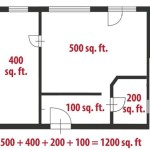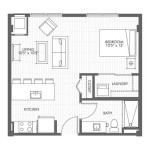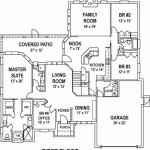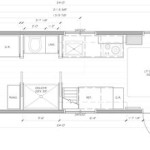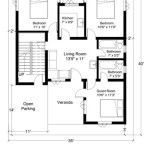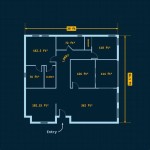How To Find The Floor Plan Of My House
Locating the floor plan of a house can be beneficial for various reasons, including planning renovations, understanding property layout, verifying square footage, or simply for archival purposes. The process of finding these plans can involve a number of different resources and strategies, depending on the age of the house, the location, and the availability of records. This article provides a comprehensive guide to help navigate the various avenues available to obtain a house's floor plan.
Consult Existing Home Documents and Records
The first and most direct approach is to examine any existing documents and records associated with the house. Previous owners may have retained these documents, or they might be stored amongst personal or family records. A thorough search of these resources may reveal a floor plan. The following are specific areas and documents to consider:
Deed and Mortgage Documents: While the deed primarily outlines ownership and legal descriptions of the property, sometimes mortgage documents, particularly those from when the house was initially built or during significant renovations, may include a floor plan attachment. These plans might have been required by the lender to assess the value and condition of the property.
Home Inspection Reports: If a home inspection was conducted when the house was purchased, the report might contain a basic sketch of the floor plan. While these are not usually professional architectural drawings, they can provide a general overview of the layout, room dimensions, and the location of key features. The inspector would have measured the rooms as part of their assessment.
Appraisal Reports: Similar to home inspection reports, appraisal reports generated during the purchase process may also include a floor plan. Appraisers often include a rough sketch to illustrate the layout of the house and to support their valuation. This is especially true for detailed appraisals conducted for mortgage purposes.
Original Construction Documents: If the house is relatively new, the original construction documents might still be accessible. These documents should contain detailed floor plans, elevation drawings, and other architectural specifications. The previous owner might have kept a copy, or the builder might still have them on file.
Renovation Permits and Drawings: If the house has undergone any significant renovations or additions, permits would have been required from the local building department. These permits generally require detailed drawings, including floor plans, which show the proposed changes. Searching for records of past renovations at the local permitting office might yield valuable information.
Homeowner's Insurance Policy: While not always the case, sometimes homeowner's insurance policies might include a simplified floor plan as part of the documentation. This is more common for high-value properties or those with specific insurance requirements, as the insurance company may need to understand the layout for risk assessment purposes.
Thoroughly reviewing these documents can often provide a readily available floor plan without needing to search external sources. Keeping these records organized and accessible can greatly simplify the process of finding these plans in the future.
Explore Local Government Records and Archives
If existing home documents do not yield a floor plan, the next step involves exploring local government records and archives. These records are typically maintained by city or county agencies and can be accessed through official channels. The following are key departments and resources to investigate:
Building Department/Permitting Office: As mentioned previously, any construction or renovation project requiring a permit is likely to have associated plans on file with the local building department or permitting office. These plans are considered public record (with potential exceptions for sensitive security features) and can usually be accessed by submitting a formal request. The process may involve paying a fee for document retrieval and photocopying.
Assessor's Office: The assessor's office is responsible for determining the property's assessed value for tax purposes. While they don't always have detailed floor plans, they may have basic property sketches that show the outline of the house, room dimensions, and the overall layout. These sketches are often based on the original building plans or subsequent surveys of the property.
County Recorder's Office/Land Registry: This office maintains records related to land ownership and property transactions. While they typically do not hold floor plans, they may have references to documents that do, such as subdivision plats or surveys that include building footprints and dimensions.
Historical Societies and Archives: For older homes, historical societies and archives may possess architectural drawings or building plans that date back to the original construction. These organizations often collect and preserve historical documents related to local buildings and properties. Contacting local historical societies or searching their online databases may uncover valuable plans.
When contacting these government agencies, be prepared to provide specific information about the property, such as the address, parcel number, owner's name, and any relevant dates (e.g., the year the house was built or when renovations were completed). This information will help them locate the relevant records more efficiently.
It's also important to understand the local procedures for accessing public records. Some agencies may require a written request, while others may allow online access to certain documents. Fees for document retrieval can vary, so inquire about these costs beforehand. Patience and persistence are often required when searching through government records, but the effort can be worthwhile in obtaining a complete floor plan.
Utilize Online Resources and Professional Assistance
In situations where traditional document searches and government archives do not yield the desired floor plan, online resources and professional assistance can provide alternative solutions. These options might involve leveraging online databases, hiring professional surveyors or architects, or exploring specialized services that offer floor plan reconstruction.
Online Property Databases: Several online real estate platforms and property databases, such as Zillow, Redfin, and local county GIS websites, often contain information about property layouts, including approximate floor plans or property sketches. While these plans may not be as detailed as architectural drawings, they can provide a general overview of the room arrangement and dimensions. These databases typically aggregate data from various sources, including assessor's offices, real estate listings, and public records.
Architectural and Drafting Services: If an accurate and detailed floor plan is required, hiring a professional architect or drafting service is a viable option. These professionals can visit the property, take precise measurements, and create a floor plan based on their observations and measurements. They can also recreate historical floor plans based on available documentation or historical research. The cost of these services can vary depending on the size and complexity of the house, but the result will be a professional-quality floor plan that meets specific needs.
Surveying Services: Surveyors are typically hired to determine property boundaries, but they can also create detailed site plans that show the location of buildings, structures, and other improvements on the property. These site plans may include a basic floor plan of the house, showing the exterior dimensions and layout. Surveyors can also provide elevations and other information that can be used to create a more comprehensive floor plan.
Floor Plan Reconstruction Services: Some specialized services focus on reconstructing floor plans from existing photographs, sketches, or descriptions. These services use computer-aided design (CAD) software and advanced algorithms to create accurate and detailed floor plans from limited information. This option can be useful for older homes where original plans are not available, but where some historical documentation exists.
Home Improvement Software and Apps: For individuals who want to create their own floor plan, several home improvement software programs and mobile apps are available. These tools allow users to draw floor plans, add furniture and fixtures, and visualize the layout of their homes. While these programs may not be as accurate as professional services, they can be a cost-effective way to create a basic floor plan for planning purposes.
When utilizing online resources or professional assistance, it is important to verify the accuracy and reliability of the information. Property databases may contain outdated or inaccurate information, and professional services can vary in quality and experience. It is advisable to check the credentials and references of any professionals hired and to compare information from multiple sources to ensure accuracy.
Finding the floor plan of a house can sometimes prove challenging, but with a systematic approach and the utilization of various resources, it is often possible to obtain the required information. This article has outlined the key areas to investigate, from existing home documents to local government records, online databases, and professional services. Each resource offers a unique set of advantages, and the most effective strategy may involve a combination of these approaches. The information obtained can be invaluable for renovation projects, property assessment, or simply for archiving a detailed record of a home's layout.

9 Ways To Find Floor Plans Of An Existing House Blueprints Archid

How To Find The Original Floor Plans For Your House

Archimple Finding Building Plans And Floor For Your House Tips Resources

How To Get Blueprints Of Your House

How Do I Get A Floor Plan For My Property

How To Read A Floor Plan With Dimensions Houseplans Blog Com

Where You Can Buy House Plans Live Home 3d

How To Read A Floor Plan And Design The Perfect Home For You

House Plan Wikipedia

Archimple How To Get Blueprints Of My House The Complete Guide
Related Posts

